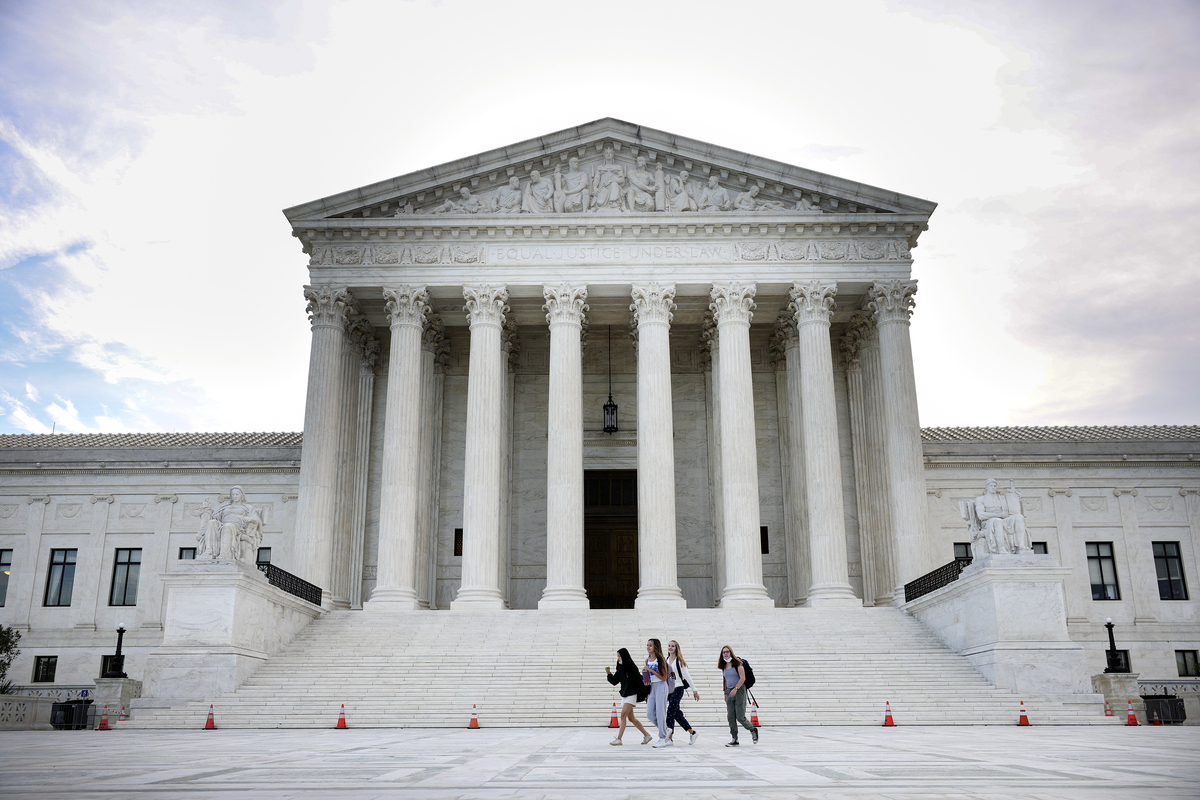Supreme Court Rules Again Police Have No Lawful Duty to Protect Anyone

No justices dissented in Monday's Supreme Court decision that preserved the qualified amnesty doctrine in two cases involving allegations of excessive force by police officers. Kevin Dietsch/Getty Images hide explanation
toggle caption
Kevin Dietsch/Getty Images

No justices dissented in Mon'south Supreme Court conclusion that preserved the qualified immunity doctrine in two cases involving allegations of excessive force by police officers.
Kevin Dietsch/Getty Images
The U.S. Supreme Court has ruled in favor of constabulary officers in two cases involving qualified immunity, the controversial legal doctrine that protects police officers accused of misconduct.
The ii cases concerned police officers defendant of using excessive force when responding to domestic disturbances. In one, officers used beanbag rounds and a human knee on the suspect's back to subdue him; in the second, officers shot and killed the suspect subsequently he approached them while raising a hammer.
Both decisions the court issued Monday were unsigned. No justices dissented.
Qualified immunity refers to a serial of legal precedents that protect government officials — including law officers — accused of violating constitutional rights.
To win a civil conform against a law officeholder, complainants must evidence that the officer violated "conspicuously established law," most often by pointing to factually similar previous cases. Otherwise, officers are protected from liability.
Police advocates say that qualified immunity is necessary so that police officers can practice their often-unsafe jobs without fear of frivolous lawsuits.
But those in favor of criminal justice reform say the doctrine has essentially created a Catch-22. Officers are shielded from liability fifty-fifty when information technology appears they violated ceremonious rights because there is no "previously established police" to challenge them because like cases accept not been pursued because officers are shielded from such cases.
In practice, the doctrine has shielded officers from liability in hundreds of civil cases, even when accused of destroying property, killing innocent people they mistook for suspects or stealing thousands of dollars.
The cases involved police force officers accused of excessive use of force
The get-go of Mon'southward 2 cases concerned Daniel Rivas-Villegas, a police officer in Union City, Calif., who responded to a 911 telephone call from a 12-twelvemonth-sometime girl who, forth with her female parent and 15-year-onetime sister, had barricaded herself inside a room to hide from her mother's boyfriend, Ramon Cortesluna, who was reportedly using a chainsaw to destroy things in the house.
When officers arrived and confronted Cortesluna, they discovered he was carrying a knife. Another officer fired ii nonlethal beanbag rounds at Cortesluna, after which he followed police force orders to lie downward. Rivas-Villegas knelt on Cortesluna's back and held upwardly his arms as another officeholder retrieved the pocketknife. After the incident, Cortesluna sued over use of excessive force.
The ninth Circuit Courtroom of Appeals institute that Rivas-Villegas was non entitled to qualified immunity, citing similarities to a previous example called LaLonde vs. the County of Riverside, in which two police officers were denied qualified immunity after kneeling on a facedown unresisting suspect named John LaLonde.
But in reversing the appeals court'south determination, the Supreme Courtroom cited several factors gear up the two incidents apart: The officers in LaLonde were responding to a noise complaint, non a domestic violence emergency; LaLonde was unarmed, while Cortesluna was carrying a knife; and Rivas-Villegas had knelt on Cortesluna for only eight seconds equally officers retrieved the knife.
In the 2d example, 3 constabulary officers in Tahlequah, Okla., responded to an emergency phone call from a woman whose ex-husband, Dominic Rollice, was drunk and refusing to leave her home.
The officers confronted Rollice in the garage, where he grabbed a hammer. The officers drew their guns and yelled for Rollice to drop it. Instead, Rollice moved toward them and raised the hammer higher; 2 officers shot and killed him.
A lower courtroom found that the Tahlequah officers had violated Rollice's Quaternary Amendment rights when they "recklessly created the situation that led to the fatal shooting."
The Supreme Court reversed the court's decision, saying "not i" of the cases cited by the lower courtroom "comes close to establishing that the officers' carry was unlawful."
The doctrine has critics, simply so far, efforts to alter it take not succeeded
Justices Sonia Sotomayor and Clarence Thomas — amongst the court's most liberal and about conservative members, respectively — have previously criticized qualified immunity, though neither issued a dissent Mon.
Congressional Democrats have made multiple attempts in recent years to limit qualified immunity, though none has been successful. The George Floyd Justice In Policing Act, which passed the Firm, would have restricted the defense, simply negotiations over a compromise bill petered out earlier this twelvemonth.
"By shielding police officers from accountability, qualified immunity encourages more police violence against Blackness and Brown people," said Sen. Ed Markey of Massachusetts, a co-sponsor of a standalone Senate bill that would end qualified amnesty, on Twitter after Monday's ruling.
Source: https://www.npr.org/2021/10/18/1047085626/supreme-court-police-qualified-immunity-cases
0 Response to "Supreme Court Rules Again Police Have No Lawful Duty to Protect Anyone"
Post a Comment